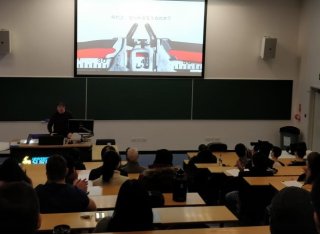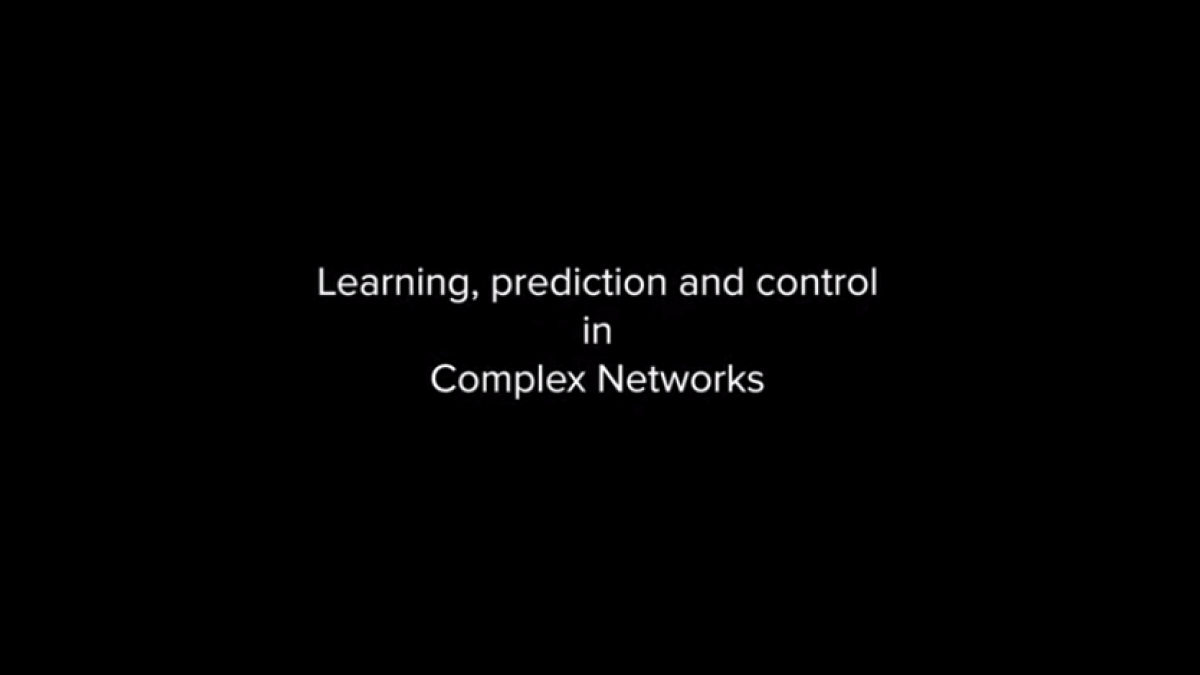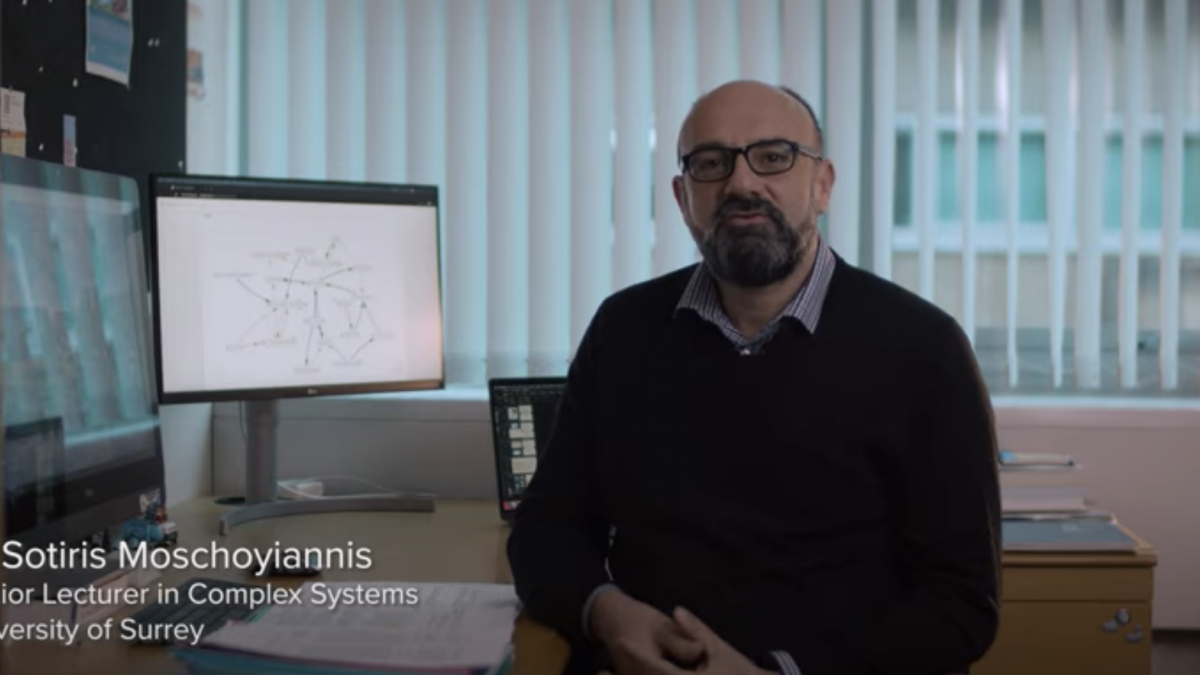
Dr Sotiris Moschoyiannis
About
Biography
I am a mathematician (Maths, University of Patras) doing research in computer science (PhD in Theoretical Computer Science, University of Surrey). My work on Learning and Control in complex networks focuses on when and where to intervene in a network in order to steer to a desirable outcome. I am keen on mathematical methods (control theory, approximations methods) combined with computational methods such as Reinforcement Learning (rule-based, deep).
I am a member of the executive committee of the IEEE Technical Committee on Cloud Computing and the technical committee on IEEE Industrial Informatics.
On the Programme Committee for the annual conference on Complex Networks, the IEEE Service Oriented Computing and Applications (IEEE SOCA), and RuleML+RR (co-Chair in 2020) and the International Rule Challenge (Chair in 2019) for the past 10 years or so.
An IEEE Member (No. 41465193).
University roles and responsibilities
- Postgraduate Research Director (PGRD) in the School of Computer Science and Electronic Engineering
- Postgraduate Research Director (PGRD) in the Computer Science Research Centre
- EIT Liaison Academic
Affiliations and memberships
News
ResearchResearch interests
I am interested in devising the best way to act in problems modelled as complex networks, or more generally real-world situations represented as dynamical systems. The objective is to get a handle on how such systems may evolve over time. My formal methods and verification background means I come from an analytical and computational perspective. My research focuses on applying mathematical methods (e.g., control theory, approximation methods, stochastic optimisation) and computational techniques (rule-based machine learning, deep reinforcement learning) to the controllability of complex networks. This video will give you a quick overview.
This research is applicable to:
- Targeted therapeutics - Gene Regulatory Networks; designing a control policy to guide therapeutic interventions
- Transportation Systems - Rail and Road networks; modelling and predicting flows of trains, cars, people, goods in urban environments
- Cyber security - APTs in 5G networks and Location Proof Systems (LPS); resilience of networks to dynamic (re)configuration
Here are some slides from the IEEE SOCA 2019 talk (19 November 2019) on serving AI workloads in resource constrained environments, more specifically AWS and lambda functions.
Here are some slides on the Real Time Flow project, and CCTool, presented at the London Node of EIT Digital (January 2020).
The Complex Control tool (CCTool) combines results from structural controllability theory, network analysis and machine learning / AI to identify the most influential nodes (drivers), and develop control policies to direct the network to a desired state. This is joint work with Alexandra Penn and Nicholas Elia, Matthew Karlsen, George Papagiannis, Vlad Georgiev and Angelos Christidis and it originates in the EPSRC ERIE project.
Research interests
I am interested in devising the best way to act in problems modelled as complex networks, or more generally real-world situations represented as dynamical systems. The objective is to get a handle on how such systems may evolve over time. My formal methods and verification background means I come from an analytical and computational perspective. My research focuses on applying mathematical methods (e.g., control theory, approximation methods, stochastic optimisation) and computational techniques (rule-based machine learning, deep reinforcement learning) to the controllability of complex networks. This video will give you a quick overview.
This research is applicable to:
- Targeted therapeutics - Gene Regulatory Networks; designing a control policy to guide therapeutic interventions
- Transportation Systems - Rail and Road networks; modelling and predicting flows of trains, cars, people, goods in urban environments
- Cyber security - APTs in 5G networks and Location Proof Systems (LPS); resilience of networks to dynamic (re)configuration
Here are some slides from the IEEE SOCA 2019 talk (19 November 2019) on serving AI workloads in resource constrained environments, more specifically AWS and lambda functions.
Here are some slides on the Real Time Flow project, and CCTool, presented at the London Node of EIT Digital (January 2020).
The Complex Control tool (CCTool) combines results from structural controllability theory, network analysis and machine learning / AI to identify the most influential nodes (drivers), and develop control policies to direct the network to a desired state. This is joint work with Alexandra Penn and Nicholas Elia, Matthew Karlsen, George Papagiannis, Vlad Georgiev and Angelos Christidis and it originates in the EPSRC ERIE project.
Teaching
Machine Learning and Data Mining (COMM055) for Postgraduate Taught students on the MSc in Data Science programme in Semester 2 2024-25. Specifically, I teach Reinforcement Learning, and Rule-based Machine Learning.
Database Systems (COMM051) for Postgraduate Taught students on the MSc in Data Science and MSc in Information Security programmes in Semester 1 2024-25.
Lecture notes, exercises, and other related material on these courses can be found on SurreyLearn.
Sustainable development goals
My research interests are related to the following:







Publications
Randomized controlled trials (RCTs) remain the benchmark for assessing treatment effects but are limited to phenotypically narrow populations by design. We introduce a novel generative artificial intelligence (AI) driven emulation method that infers effect size through virtual clinical trials, which can emulate the RCT process and potentially extrapolate into wider populations. We validate the virtual trials by comparing the predicted impact of glucagon-like peptide-1 (GLP-1) agonists on HbA1c in type-2 diabetes (T2DM) with its true efficacy established in the LEAD-5 trial. Our emulation model learns treatment effects from real-world evidence data by a combined generative AI and causal learning approach. Training data comprised pre- and post-treatment outcomes for 5,476 people with T2DM. We considered three treatment arms: GLP-1 (Liraglutide), basal insulin (glargine), and placebo. After training, virtual trials were conducted by sampling 232 virtual patients per arm (according to the LEAD-5 inclusion criteria) and predicting post-treatment outcomes. We used difference-in-differences (DiD) for pairwise comparisons between arms. Our goal was to emulate LEAD-5 by demonstrating a significant DiD in post-treatment HbA1c reduction for GLP-1 compared to basal insulin and placebo. We found significant differences in HbA1c reduction for GLP-1 vs basal insulin (-1.21 mmol/mol (-0.11%); p
Probabilistic Boolean Networks have been proposed for estimating the behaviour of dynamical systems as they combine rule-based modelling with uncertainty principles. Inferring PBNs directly from gene data is challenging however, especially when data is costly to collect and/or noisy, e.g., in the case of gene expression profile data. In this paper , we present a reproducible method for inferring PBNs directly from real gene expression data measurements taken when the system was at a steady state. The steady-state dynamics of PBNs is of special interest in the analysis of biological machinery. The proposed approach does not rely on reconstructing the state evolution of the network, which is com-putationally intractable for larger networks. We demonstrate the method on samples of real gene expression profiling data from a well-known study on metastatic melanoma. The pipeline is implemented using Python and we make it publicly available.
Primary care data in the UK are widely used for cancer research, but the reliability of recording key events like diagnoses remains uncertain. Although data linkage can improve reliability, its costs, time requirements, and sample size constraints may discourage its use. We evaluated accuracy, completeness, and date concordance of prostate cancer (PCa) diagnosis recording in Clinical Practice Research Datalink (CPRD) GOLD and Aurum compared to linked Cancer Registry (CR) and Hospital Episode Statistics (HES) Admitted Patient Care (APC) in England. Incident PCa diagnoses (2000-2016) for males aged ≥46 at diagnosis who remained registered with their General Practitioner (GP) by age 65 and were recorded in at least one data source were analysed. Accuracy was the proportion of diagnoses recorded in GOLD or Aurum with a corresponding record in CR or HES. Completeness was the proportion of CR or HES diagnoses with a corresponding record in GOLD or Aurum. The final cohorts for comparisons included 29,500 records for GOLD and 26,475 for Aurum. Compared to CR, GOLD was 86 % accurate and 65 % complete, while Aurum was 87 % accurate and 77 % complete. Compared to HES, GOLD was 76 % accurate and 60 % complete, and Aurum was 79 % accurate and 70 % complete. Concordance in diagnosis dates improved over time in both GOLD and Aurum, with 93 % of diagnoses recorded within a year compared to CR, and 66 % (GOLD) and 71 % (Aurum) compared to HES. Delays of 2-3 weeks in primary care diagnosis recording were observed compared to CR, whereas most diagnoses appeared at least 3 months earlier in primary care than in HES. Aurum demonstrated better accuracy and completeness for PCa diagnosis recording than GOLD. However, linkage to HES or CR is recommended for improved case capture. Researchers should address the limitations of each data source to ensure research validity.
The ability to direct a Probabilistic Boolean Network (PBN) to a desired state is important to applications such as targeted therapeutics in cancer biology. Reinforcement Learning (RL) has been proposed as a framework that solves a discrete-time optimal control problem cast as a Markov Decision Process. We focus on an integrative framework powered by a model-free deep RL method that can address different flavours of the control problem (e.g., with or without control inputs; attractor state or a subset of the state space as the target domain). The method is agnostic to the distribution of probabilities for the next state, hence it does not use the probability transition matrix. The time complexity is linear on the time steps, or interactions between the agent (deep RL) and the environment (PBN), during training. Indeed, we explore the scalability of the deep RL approach to (set) stabilization of large-scale PBNs and demonstrate successful control on large networks, including a metastatic melanoma PBN with 200 nodes.
IntroductionIn the UK, primary care data are often used for cancer-related research, but the accuracy of cancer information is uncertain. ObjectiveWe investigated socio-demographic variation based on the recording date of prostate cancer diagnosis between primary care and the National Cancer Registry (CR). ApproachWe utilised a data extract of 1,600,000 patients over 65 years from Clinical Practice Research Datalink (CPRD). We extracted prostate cancer diagnoses using Read and SNOMED-CT codes from primary care, and ICD-10 from CR. Initial code entry determined diagnosis dates. We categorised recording timing differences as earlier, same-day or later in primary care than CR and used the chi-squared test and logistic regression (adjusted for recording year) to compare these discrepancies across age, deprivation, and ethnicity. ResultsWe included 26,875 men with prostate cancer diagnoses commonly recorded in both sources during 2000-2016 (1,030 excluded with missing ethnicity). Compared to CR, 1,747 (7%) had diagnoses recorded on the same day in primary care, while 20,615 (77%) had later recordings with a median delay of 21 days (IQR: 13-38). Age at diagnosis was associated with recording discrepancies (p
DERM is an AI algorithm for detecting skin cancer. Developed by Skin Analytics, the algorithm analyses images of skin lesions and determines if the lesion is likely to be cancerous. DERM is already being used by some NHS providers, and is integrated with existing skin cancer pathways, triaging patients before being assessed by dermatologists. The Department of Health and Social Care (DHSC) funded deployment and a real-world evaluation of DERM as part of the AI in Health and Care Award. The evaluation aimed to inform future implementation by assessing key domains such as safety, accuracy, effectiveness, value and sustainability. Working as a collaborative Technology Specific Evaluation Team (TSET), Unity Insights and University of Surrey conducted an evaluation of DERM in four NHS sites, across 9,649 patients between February 2022 and April 2023. The resulting evaluation report is presented in full.
The Internet of Vehicles (IoV), whereby interconnected vehicles communicate with each other and with road infrastructure on a common network, has promising socio-economic benefits but also poses new cyber-physical threats. Data on vehicular attackers can be realistically gathered through cyber threat intelligence using systems like honeypots. Admittedly, configuring honeypots introduces a trade-off between the level of honeypot-attacker interactions and any incurred overheads and costs for implementing and monitoring these honeypots. We argue that effective deception can be achieved through strategically configuring the honeypots to represent components of the IoV and engage attackers to collect cyber threat intelligence. In this paper, we present HoneyCar, a novel decision support framework for honeypot deception in IoV. HoneyCar builds upon a repository of known vulnerabilities of the autonomous and connected vehicles found in the Common Vulnerabilities and Exposure (CVE) data within the National Vulnerability Database (NVD) to compute optimal honeypot configuration strategies. By taking a game-theoretic approach, we model the adversarial interaction as a repeated imperfect-information zero-sum game in which the IoV network administrator chooses a set of vulnerabilities to offer in a honeypot and a strategic attacker chooses a vulnerability of the IoV to exploit under uncertainty. Our investigation is substantiated by examining two different versions of the game, with and without the re-configuration cost to empower the network administrator to determine optimal honeypot configurations. We evaluate HoneyCar in a realistic use case to support decision makers with determining optimal honeypot configuration strategies for strategic deployment in IoV.
Fifth generation mobile networks (5G) leverage the power of edge computing to move vital services closer to end users. With critical 5G core network components located at the edge there is a need for detecting malicious signalling traffic to mitigate potential signalling attacks between the distributed Network Functions (NFs). A prerequisite for detecting anomalous signalling is a network traffic dataset for the identification and classification of normal traffic profiles. To this end, we utilise a 5G Core Network (5GC) simulator to execute test scenarios for different 5G procedures and use the captured network traffic to generate a dataset of normalised service interactions in the form of packet captures. We then apply machine learning techniques (supervised learning) and do a comparative analysis on accuracy, which uses three features from the traffic meta-data. Our results show that the identification of 5G service use by applying ML techniques offer a viable solution to classifying normal services from network traffic metadata alone. This has potential advantages in forecasting service demand for resource allocation in the dynamic 5GC environment and provide a baseline for performing anomaly detection of NF communication for detecting malicious traffic within the 5G Service Based Architecture (SBA).
In this paper, we present a survey of deep learning approaches for cybersecurity intrusion detection, the datasets used, and a comparative study. Specifically, we provide a review of intrusion detection systems based on deep learning approaches. The dataset plays an important role in intrusion detection, therefore we describe 35 well-known cyber datasets and provide a classification of these datasets into seven categories; namely, network traffic-based dataset, electrical network-based dataset, internet traffic-based dataset, virtual private network-based dataset, android apps-based dataset, IoT traffic-based dataset, and internet-connected devices-based dataset. We analyze seven deep learning models including recurrent neural networks, deep neural networks, restricted Boltzmann machines, deep belief networks, convolutional neural networks, deep Boltzmann machines, and deep autoencoders. For each model, we study the performance in two categories of classification (binary and multiclass) under two new real traffic datasets, namely, the CSE-CIC-IDS2018 dataset and the Bot-IoT dataset. In addition, we use the most important performance indicators, namely, accuracy, false alarm rate, and detection rate for evaluating the efficiency of several methods.
Complexity theory has been used to study a wide range of systems in biology and nature but also business and socio-technical systems, e.g., see [1]. The ultimate objective is to develop the capability of steering a complex system towards a desired outcome. Recent developments in network controllability [2] concerning the reworking of the problem of finding minimal control configurations allow the use of the polynomial time Hopcroft- Karp algorithm instead of exponential time solutions. Subsequent approaches build on this result to determine the precise control nodes, or drivers, in each minimal control configuration [3], [4]. A browser-based analytical tool, CCTool1, for identifying such drivers automatically in a complex network has been developed in [5]. One key characteristic of a complex system is that it continuously evolves, e.g., due to dynamic changes in the roles, states and behaviours of the entities involved. This means that in addition to determining driver nodes it is appropriate to consider an evolving topology of the underlying complex network, and investigate the effect of removing nodes (and edges) on the corresponding minimal control configurations. The work presented here focuses on arriving at a classification of the nodes based on the effect their removal has on controllability of the network.
Deployed AI platforms typically ship with bulky system architectures which present bottlenecks and a high risk of failure. A serverless deployment can mitigate these factors and provide a cost-effective, automatically scalable (up or down) and elastic real-time on-demand AI solution. However, deploying high complexity production workloads into serverless environments is far from trivial, e.g., due to factors such as minimal allowance for physical codebase size, low amount of runtime memory, lack of GPU support and a maximum runtime before termination via timeout. In this paper we propose a set of optimization techniques and show how these transform a codebase which was previously incompatible with a serverless deployment into one that can be successfully deployed in a serverless environment; without compromising capability or performance. The techniques are illustrated via worked examples that have been deployed live on rail data and realtime predictions on train movements on the UK rail network. The similarities of a serverless environment to other resource constrained environments (IoT, Mobile) means the techniques can be applied to a range of use cases.
The brain is a highly reconfigurable machine capable of task-specific adaptations. The brain continually rewires itself for a more optimal configuration to solve problems. We propose a novel strategic synthesis algorithm for feedforward networks that draws directly from the brain's behaviours when learning. The proposed approach analyses the network and ranks weights based on their magnitude. Unlike existing approaches that advocate random selection, we select highly performing nodes as starting points for new edges and exploit the Gaussian distribution over the weights to select corresponding endpoints. The strategy aims only to produce useful connections and result in a smaller residual network structure. The approach is complemented with pruning to further the compression. We demonstrate the techniques to deep feedforward networks. The residual sub-networks that are formed from the synthesis approaches in this work form common sub-networks with similarities up to ~90%. Using pruning as a complement to the strategic synthesis approach, we observe improvements in compression.
Probabilistic Boolean Networks (PBNs) were introduced as a computational model for the study of complex dynamical systems, such as Gene Regulatory Networks (GRNs). Controllability in this context is the process of making strategic interventions to the state of a network in order to drive it towards some other state that exhibits favourable biological properties. In this paper we study the ability of a Double Deep Q-Network with Prioritized Experience Replay in learning control strategies within a finite number of time steps that drive a PBN towards a target state, typically an attractor. The control method is model-free and does not require knowledge of the network's underlying dynamics, making it suitable for applications where inference of such dynamics is intractable. We present extensive experiment results on two synthetic PBNs and the PBN model constructed directly from gene-expression data of a study on metastatic-melanoma.
In this paper we are concerned with providing support for business activities in moving from value chains to value networks. We describe a fully distributed P2P architecture which reflects the dynamics of business processes that are not governed by a single organisation. The temporary virtual networks of long-term business transactions are used as the building block of the overall scale-free business network. The design is based on dynamically formed permanent clusters resulting in a topology that is highly resilient to failures (and attacks) and is capable of reconfiguring itself to adapt to changes in business models and respond to global failures of conceptual hubs. This fosters an environment where business communities can evolve to meet emerging business opportunities and achieve sustainable growth within a digital ecosystem.
One of the barriers for the adoption of Electric Vehicles (EVs) is the anxiety around the limited driving range. Recent proposals have explored charging EVs on the move, using dynamic wireless charging which enables power exchange between the vehicle and the grid while the vehicle is moving. In this article, we focus on the intelligent routing of EVs in need of charging so that they can make most efficient use of the so-called Mobile Energy Disseminators (MEDs) which operate as mobile charging stations. We present a method for routing EVs around MEDs on the road network, which is based on constraint logic programming and optimization using a graph-based shortest path algorithm. The proposed method exploits Inter-Vehicle (IVC) communications in order to eco-route electric vehicles. We argue that combining modern communications between vehicles and state of the art technologies on energy transfer, the driving range of EVs can be extended without the need for larger batteries or overtly costly infrastructure. We present extensive simulations in city conditions that show the driving range and consequently the overall travel time of electric vehicles is improved with intelligent routing in the presence of MEDs.
Gene regulatory networks represent collections of regulators that interact with each other and with other molecules to govern gene expression. Biological signalling networks model how signals are transmitted and how activities are coordinated in the cell. The study of the structure of such networks in complex diseases such as cancer can provide insights into how they function, and consequently, suggest suitable treatment approaches. Here, we explored such topological characteristics in the example of a mitogen-activated protein kinase (MAPK) signalling network derived from published studies in cancer. We employed well-established techniques to conduct network analyses, and collected information on gene function as obtained from large-scale public databases. This allowed us to map topological and functional relationships, and build hypotheses on this network's functional consequences. In particular, we find that the topology of this MAPK network is highly non-random, modular and robust. Moreover, analysis of the network's structure indicates the presence of organisational features of cancer hallmarks, expressed in an asymmetrical manner across communities of the network. Finally, our results indicate that the organisation of this network renders it problematic to use treatment approaches that focus on a single target. Our analysis suggests that multi-target attacks in a well-orchestrated manner are required to alter how the network functions. Overall, we propose that complex network analyses combined with pharmacological insights will help inform on future treatment strategies, exploiting structural vulnerabilities of signalling and regulatory networks in cancer.
In this paper we explore the concept of ldquoecosystemrdquo as a metaphor in the development of the digital economy. We argue that the modelling of social ecosystems as self-organising systems is also relevant to the study of digital ecosystems. Specifically, that centralised control structures in digital ecosystems militate against emergence of innovation and adaptive response to pressures or shocks that may impact the ecosystem. We hope the paper will stimulate a more holistic approach to gaining empirical and theoretical understanding of digital ecosystems.
Steering a complex system towards a desired outcome is a challenging task. The lack of clarity on the system’s exact architecture and the often scarce scientific data upon which to base the op- erationalisation of the dynamic rules that underpin the interactions between participant entities are two contributing factors. We describe an analytical approach that builds on Fuzzy Cognitive Map- ping (FCM) to address the latter and represent the system as a complex network. We apply results from network controllability to address the former and determine minimal control configurations - subsets of factors, or system levers, which comprise points for strategic intervention in steering the system. We have implemented the combination of these techniques in an analytical tool that runs in the browser, and generates all minimal control configurations of a complex network. We demonstrate our approach by reporting on our experience of working alongside industrial, local-government, and NGO stakeholders in the Humber region, UK. Our results are applied to the decision-making process involved in the transition of the region to a bio-based economy.
We present a Peer-to-Peer network design which aims to support business activities conducted through a network of collaborations that generate value in different, mutually beneficial, ways for the participating organisations. The temporary virtual networks formed by long-term business transactions that involve the execution of multiple services from different providers are used as the building block of the underlying scale-free business network. We show how these local interactions, which are not governed by a single organisation, give rise to a fully distributed P2P architecture that reflects the dynamics of business activities. The design is based on dynamically formed permanent clusters of nodes, the so-called Virtual Super Peers (VSPs), and this results in a topology that is highly resilient to certain types of failure (and attacks). Furthermore, the proposed P2P architecture is capable of reconfiguring itself to adapt to the usage that is being made of it and respond to global failures of conceptual hubs. This fosters an environment where business communities can evolve to meet emerging business opportunities and achieve sustainable growth within a digital ecosystem.
In the maritime environment, navigation and localisation are primarily driven by systems such as GPS. However, in a scenario where GPS is not available, e.g., it is jammed or the satellite connection was lost, navigators can use visual methods derived from surrounding land masses and other permanent features in the perceptual range. To enable autonomous navigation, specifically localisation, a vessel must determine its position by extracting and matching the contours of its surrounding environment with an elevation model. The contours of interest are the true horizon line, visible horizon line and shoreline. Extracting these contours is commonly approached using computational methods such as edge detection or pixel clustering techniques that are not robust and build on weak priors. To this end, we propose the first learning-based framework that explores the fusion of inertial data into an encoder-decoder model and extracts the contours. In addition, extensive data augmentation methods are used to extend the MaSTr1325 dataset, introducing further robustness to the common environmental challenges faced by the sensors of unmanned surface vessels. We form a small curated dataset containing 300 images - composed of six component segmentation masks and three further masks describing the true horizon and visible horizon contours and the shoreline, for evaluation. We experimented extensively with popular segmentation models such as UNet, SegNet, DeepLabV3+ and TransUNet with various backbones for a quantitative comparison. The results show that, within a small margin of ten pixels and in a high-resolution image, our system detects three key contours, namely shorelines, true and visible horizon contours, used in navigation with an accuracy of 63.79%, 68.94% and 89.75%, respectively.
With REST becoming the dominant architectural paradigm for web services in distributed systems, more and more use cases are applied to it, including use cases that require transactional guarantees. We propose a RESTful transaction model that satisfies both the constraints of transactions and those of the REST architectural style. We then apply the isolation theorems to prove the robustness of its properties on a formal level.
Concurrency control mechanisms such as turn-taking, locking, serialization, transactional locking mechanism, and operational transformation try to provide data consistency when concurrent activities are permitted in a reactive system. Locks are typically used in transactional models for assurance of data consistency and integrity in a concurrent environment. In addition, recovery management is used to preserve atomicity and durability in transaction models. Unfortunately, conventional lock mechanisms severely (and intentionally) limit concurrency in a transactional environment. Such lock mechanisms also limit recovery capabilities. Finally, existing recovery mechanisms themselves afford a considerable overhead to concurrency. This paper describes a new transaction model that supports release of early results inside and outside of a transaction, decreasing the severe limitations of conventional lock mechanisms, yet still warranties consistency and recoverability of released resources (results). This is achieved through use of a more flexible locking mechanism and by using two types of consistency graph. This provides an integrated solution for transaction management, recovery management and concurrency control. We argue that these are necessary features for management of long-term transactions within "digital ecosystems" of small to medium enterprises.
We describe a translation of scenarios given in UML 2.0 sequence diagrams into a tuples-based behavioural model that considers multiple access points for a participating instance and exhibits true-concurrency. This is important in a component setting since different access points are connected to different instances, which have no knowledge of each other. Interactions specified in a scenario are modelled using tuples of sequences, one sequence for each access point. The proposed unfolding of the sequence diagram involves mapping each location (graphical position) onto the so-called component vectors. The various modes of interaction (sequential, alternative, concurrent) manifest themselves in the order structure of the resulting set of component vectors, which captures the dependencies between participating instances. In previous work, we have described how (sets of) vectors generate concurrent automata. The extension to our model with sequence diagrams in this paper provides a way to verify the diagram against the state-based model.
This paper presents a true-concurrent approach to formalising integration of Small-to-Medium Enterprises (SMEs) with Web services. Our approach formalises common notions in service-oriented computing such as conversations (interactions between clients and web services), multi-party conversations (interactions between multiple web services) and coordination protocols, which are central in a transactional environment. In particular, we capture long-running transactions with recovery and compensation mechanisms for the underlying services in order to ensure that a transaction either commits or is successfully compensated for. © 2008 Springer-Verlag Berlin Heidelberg.
The aim of this paper is to facilitate e-business transactions between small and medium enterprises (SMEs), in a way that respects their local autonomy, within a digital ecosystem. For this purpose, we distinguish transactions from services (and service providers) by considering virtual private transaction networks (VPTNs) and virtual service networks (VSNs). These two virtual levels are optimised individually and in respect to each other. The effect of one on the other, can supply us with stability, failure resistance and small-world characteristics on one hand and durability, consistency and sustainability on the other hand. The proposed network design has a dynamic topology that adapts itself to changes in business models and availability of SMEs, and reflects the highly dynamic nature of a digital ecosystem.
Critical cascades are found in many self-organizing systems. Here, we examine critical cascades as a design paradigm for logic and learning under the linear threshold model (LTM), and simple biologically inspired variants of it as sources of computational power, learning efficiency, and robustness. First, we show that the LTM can compute logic, and with a small modification, universal Boolean logic, examining its stability and cascade frequency. We then frame it formally as a binary classifier and remark on implications for accuracy. Second, we examine the LTM as a statistical learning model, studying benefits of spatial constraints and criticality to efficiency. We also discuss implications for robustness in information encoding. Our experiments show that spatial constraints can greatly increase efficiency. Theoretical investigation and initial experimental results also indicate that criticality can result in a sudden increase in accuracy.
SNE2EE is a messaging service that protects individuals in each and every stage of the data transfer process: creation, transmission, and reception. The aim of SNE2EE is to protect user communications not only when their date is being transported to another user via secure ports/protocols, but also while they are being created.
In this paper we present a prototype of a tool that demonstrates how existing limitations in ensuring an agent’s compliance to an argumentation-based dialogue protocol can be overcome. We also present the implementation of compliance enforcement components for a deliberation dialogue protocol, and an application that enables two human participants to engage in an efficiently moderated dialogue, where all inappropriate utterances attempted by an agent are blocked and prevented from inclusion within the dialogue.
In this paper we present a model for coordinating distributed long running and multi-service transactions in Digital Business EcoSystems. The model supports various forms of service composition, which are translated into a tuples-based behavioural description that allows to reason about the required behaviour in terms of ordering, dependencies and alternative execution. The compensation mechanism warranties consistency, including omitted results, without breaking local autonomy. The proposed model is considered at the deployment level of SOA, rather than the realisation level, and is targeted to business transactions between collaborating SMEs as it respects the loose-coupling of the underlying services. © 2007 IEEE.
We apply a learning classifier system, XCSI, to the task of providing personalised suggestions for passenger onward journeys. Learn- ing classifier systems combine evolutionary computation with rule-based machine learning, altering a population of rules to achieve a goal through interaction with the environment. Here XCSI interacts with a simulated environment of passengers travelling around the London Underground network, subject to disruption. We show that XCSI successfully learns individual passenger preferences and can be used to suggest personalised adjustments to the onward journey in the event of disruption.
With REST becoming a dominant architectural paradigm for web services in distributed systems, more and more use cases are applied to it, including use cases that require transactional guarantees. We believe that the loose coupling that is supported by RESTful transactions, makes this currently our preferred interaction style for digital ecosystems (DEs). To further expand its value to DEs, we propose a RESTful transaction model that satisfies both the constraints of recoverable transactions and those of the REST architectural style. We then show the correctness and applicability of the model.
This article studies an algebra-logic mixed representation of gate networks and its application to stuck-at fault diagnosis. First, the gate network is characterized through a logic expression of disjoint sum-of-products, and the system structure of the gate network is described based on 2-to-1 multiplexers. Then, by resorting to the semi-tensor product of matrices, a novel algebra-logic mixed representation is proposed for the gate network through its logic expression and system structure. Furthermore, a novel stuck-at fault diagnosis algorithm for the gate network is presented, where the stuck-at fault testability of the gate network is equivalent to the solution existence of the system of linear equations. Finally, the fault diagnosis of the 4-bit carry look-ahead adder is carried out to demonstrate the effectiveness and feasibility of the proposed theoretical approach and algorithms.
The rise of reinforcement learning (RL) has guided a new paradigm: unraveling the intervention strategies to control systems with unknown dynamics. Model-free RL provides an exhaustive framework to devise therapeutic methods to alter the regulatory dynamics of gene regulatory networks (GRNs). This paper presents an RL-based technique to control GRNs modeled as probabilistic Boolean control networks (PBCNs). In particular, a double deep-Q network (DDQN) approach is proposed to address the sampled-data control (SDC) problem of PBCNs, and optimal state feedback controllers are obtained, rendering the PBCNs stabilized at a given equilibrium point. Our approach is based on options, i.e., the temporal abstractions of control actions in the Markov decision processes (MDPs) framework. First, we define options and hierarchical options and give their properties. Then, we introduce multi-time models to compute the optimal policies leveraging the options framework. Furthermore, we present a DDQN algorithm: i) to concurrently design the feedback controller and the sampling period; ii) wherein the controller intelligently decides the sampled period to update the control actions under the SDC scheme. The presented method is model-free and offers scalability, thereby providing an efficient way to control large-scale PBCNs. Finally, we compare our control policy with state-of-the-art control techniques and validate the presented results.
We propose a set of optimization techniques for transforming a generic AI codebase so that it can be successfully deployed to a restricted serverless environment, without compromising capability or performance. These involve (1) slimming the libraries and frameworks (e.g., pytorch) used, down to pieces pertaining to the solution; (2) dynamically loading pre-trained AI/ML models into local temporary storage, during serverless function invocation; (3) using separate frameworks for training and inference, with ONNX model formatting; and, (4) performance-oriented tuning for data storage and lookup. The techniques are illustrated via worked examples that have been deployed live on geospatial data from the transportation domain. This draws upon a real-world case study in intelligent transportation looking at on-demand, realtime predictions of flows of train movements across the UK rail network. Evaluation of the proposed techniques shows the response time, for varying volumes of queries involving prediction, to remain almost constant (at 50 ms), even as the database scales up to the 250M entries. The query response time is important in this context as the target is predicting train delays. It is even more important in a serverless environment due to the stringent constraints on serverless functions’ runtime before timeout. The similarities of a serverless environment to other resource constrained environments (e.g., IoT, telecoms) means the techniques can be applied to a range of use cases.
Modern software systems become increasingly complex as they are expected to support a large variety of different functions. We need to create more software in a shorter time, and without compromising the quality of the software. In order to build such systems efficiently, a compositional approach is required. This entails some formal technique for analysis and reasoning on local component properties as well as on properties of the composite. In this paper, we present a mathematical framework for the composition of software components, at a semantic modelling level. We describe a mathematical concept of a component and identify properties that ensure its potential behaviour can be captured. Based on that, we give a formal definition of composition and examine its effect on the individual components. We argue that properties of the individual components can, under certain conditions, be preserved in the composite. The proposed framework can be used for guiding the composition of components as it advocates formal reasoning about the composite before the actual composition takes place.
Neuronal network computation and computation by avalanche supporting networks are of interest to the felds of physics, computer science (computation theory as well as statistical or machine learning) and neuroscience. Here we show that computation of complex Boolean functions arises spontaneously in threshold networks as a function of connectivity and antagonism (inhibition), computed by logic automata (motifs) in the form of computational cascades. We explain the emergent inverse relationship between the computational complexity of the motifs and their rank-ordering by function probabilities due to motifs, and its relationship to symmetry in function space. We also show that the optimal fraction of inhibition observed here supports results in computational neuroscience, relating to optimal information processing.
We describe a true-concurrent approach for managing dependencies between distributed and concurrent coordinator components of a long-running transaction. In previous work we have described how interactions specified in a scenario can be translated into a tuples-based behavioural description, namely vector languages. In this paper we show how reasoning against order-theoretic properties of such languages can reveal missing behaviours which are not explicitly described in the scenario but are still possible. Our approach supports the gradual refinement of scenarios of interaction into a complete set of behaviours that includes all desirable orderings of execution and prohibits emergent behaviour of the transaction. Crown Copyright © 2010.
Rule-based machine learning focuses on learning or evolving a set of rules that represents the knowledge captured by the system. Due to its inherent complexity, a certain amount of fine tuning is required before it can be applied to a particular problem. However, there is limited information available to researchers when it comes to setting the corresponding run parameter values. In this paper, we investigate the run parameters of Learning Classifier Systems (LCSs) as applied to single-step problems. In particular, we study two LCS variants, XCS for reinforcement learning and UCS for supervised learning, and examine the effect that different parameter values have on enhancing the model prediction, increasing accuracy and reducing the resulting rule set size.
We describe a formal approach to protocol design for dialogues between autonomous agents in a digital ecosystem that involve the exchange of arguments between the participants. We introduce a vector language-based representation of argumentation protocols, which captures the interplay between different agentspsila moves in a dialogue in a way that (a) determines the legal moves that are available to each participant, in each step, and (b) records the dialogue history. We use UML protocol state machines (PSMs) to model a negotiation dialogue protocol at both the individual participant level (autonomous agent viewpoint) and the dialogue level (overall interaction viewpoint). The underlying vector semantics is used to verify that a given dialogue was played out in compliance with the corresponding protocol.
In this paper, we describe a true-concurrent hierarchical logic interpreted over concurrent automata. Concurrent automata constitute a special kind of asynchronous transition system (ATS) used for modelling the behaviour of components as understood in component-based software development. Here, a component-based system consists of several interacting components whereby each component manages calls to and from the component using ports to ensure encapsulation. Further, a component can be complex and made of several simpler interacting components. When a complex component receives a request through one of its ports, the port delegates the request to an internal component. Our logic allows us to describe the different views we can have on the system. For example, the overall component interactions, whether they occur sequentially, simultaneously or in parallel, and how each component internally manages the received requests (possibly expressed at different levels of detail). Using concurrent automata as an underlying formalism we guarantee that the expressiveness of the logic is preserved in the model. In future work, we plan to integrate our truly-concurrent approach into the Edinburgh Concurrency Workbench. © 2007 Elsevier B.V. All rights reserved.
In this paper we describe the application of a Deep Reinforcement Learning agent to the problem of control of Gene Regulatory Networks (GRNs). The proposed approach is applied to Random Boolean Networks (RBNs) which have extensively been used as a computational model for GRNs. The ability to control GRNs is central to therapeutic interventions for diseases such as cancer. That is, learning to make such interventions as to direct the GRN from some initial state towards a desired attractor, by allowing at most one intervention per time step. Our agent interacts directly with the environment; being an RBN, without any knowledge of the underlying dynamics, structure or connectivity of the network. We have implemented a Deep Q Network with Double Q Learning that is trained by sampling experiences from the environment using Prioritized Experience Replay. We show that the proposed novel approach develops a policy that successfully learns how to control RBNs significantly larger than previous learning implementations. We also discuss why learning to control an RBN with zero knowledge of its underlying dynamics is important and argue that the agent is encouraged to discover and perform optimal control interventions in regard to cost and number of interventions.
The increased use of smart Electric Vehicles (EVs) and Plug-in Electric Vehicles (PEV) opened a new area of research and development. The number of EV charging sites has considerably increased in residential as well as in public areas. Within these EV charging sites, various entities need to communicate in a secure and efficient way. The Open Charge Point Protocol (OCPP) offers a way to coordinate this communication and is already being used in many implementations. However, only the latest OCPP 2.0 version of the protocol includes certain security features. In this article, we present the entities that take part in an OCPP-based smart charging scenario, we identify security issues and threats and present solutions that have been proposed by scholars. We identify open security issues for OCPP and propose future research directions for the security enhancement of the protocol.
This article discusses how the gap between early 5G network threat assessments and an adversarial Tactics, Techniques, Procedures (TTPs) knowledge base for future use in the MITRE ATT&CK threat modelling framework can be bridged. We identify knowledge gaps in the existing framework for key 5G technology enablers such as SDN, NFV, and 5G specific signalling protocols of the core network. We adopt a pre-emptive approach to identifying adversarial techniques which can be used to launch attacks on the 5G core network (5GCN) and map these to its components. Using relevant 5G threat assessments along with industry reports, we study how the domain specific techniques can be employed by APTs in multi-stage attack scenarios based on historic telecommunication network attacks and motivation of APT groups. We emulate this mapping in a pre-emptive fashion to facilitate a rigorous cyber risk assessment, support intrusion detection, and design defences based on common APT TTPs in a 5GCN.
This paper shows the early results of new research on how Digital Ecosystems can promote new modes of sustainable e-business practices, for Small and Medium-Sized Enterprises (SMEs), using an open architecture for content sharing and Business-to-Business (B2B) interactions in the knowledge economy, and within a framework of open standards. The current e-business practices and technologies do not always encourage openness but instead tend to promote established models of proprietary e-business development based on centralised network and service infrastructure. Governments can promote open developments by supporting opportunities for new entry through supporting and augmenting a market environment for the productive coexistence of large and small companies in the B2B e-commerce domain.
The distinct feature of this volume is its focus on mathematical models that identify the "core" concepts as first class modeling elements, and its providing of techniques for integrating and relating them.
The Electric Vehicles (EVs) market has seen rapid growth recently despite the anxiety about driving range. Recent proposals have explored charging EVs on the move, using dynamic wireless charging that enables power exchange between the vehicle and the grid while the vehicle is moving. Specifically, part of the literature focuses on the intelligent routing of EVs in need of charging. Inter-Vehicle communications (IVC) play an integral role in intelligent routing of EVs around a static charging station or dynamic charging on the road network. However, IVC is vulnerable to a variety of cyber attacks such as spoofing. In this paper, a probabilistic cross-layer Intrusion Detection System (IDS), based on Machine Learning (ML) techniques, is introduced. The proposed IDS is capable of detecting spoofing attacks with more than 90% accuracy. The IDS uses a new metric, Position Verification using Relative Speed (PVRS), which seems to have a significant effect in classification results. PVRS compares the distance between two communicating nodes that is observed by On-Board Units (OBU) and their estimated distance using the relative speed value that is calculated using interchanged signals in the Physical (PHY) layer.
Random Boolean Networks (RBNs) are an arguably simple model which can be used to express rather complex behaviour, and have been applied in various domains. RBNs may be controlled using rule-based machine learning, specifically through the use of a learning classifier system (LCS) – an eXtended Classifier System (XCS) can evolve a set of condition-action rules that direct an RBN from any state to a target state (attractor). However, the rules evolved by XCS may not be optimal, in terms of minimising the total cost along the paths used to direct the network from any state to a specified attractor. In this paper, we present an algorithm for uncovering the optimal set of control rules for controlling random Boolean networks. We assign relative costs for interventions and ‘natural’ steps. We then compare the performance of this optimal rule calculator algorithm (ORC) and the XCS variant of learning classifier systems. We find that the rules evolved by XCS are not optimal in terms of total cost. The results provide a benchmark for future improvement.
Declarative technologies have made great strides in expressivity between SQL and SBVR. SBVR models are more expressive that SQL schemas, but not as imminently executable yet. In this paper, we complete the architecture of a system that can execute SBVR models. We do this by describing how SBVR rules can be transformed into SQL DML so that they can be automatically checked against the database using a standard SQL query. In particular, we describe a formalization of the basic structure of an SQL query which includes aggregate functions, arithmetic operations, grouping, and grouping on condition. We do this while staying within a predicate calculus semantics which can be related to the standard SBVR-LF specification and equip it with a concrete semantics for expressing business rules formally. Our approach to transforming SBVR rules into standard SQL queries is thus generic, and the resulting queries can be readily executed on a relational schema generated from the SBVR model.
The fifth generation of mobile networks (5G) promises a range of new capabilities including higher data rates and more connected users. To support the new capabilities and use cases the 5G Core Network (5GCN) will be dynamic and reconfigurable in nature to deal with demand. It is these improvements which also introduce issues for traditional security monitoring methods and techniques which need to adapt to the new network architecture. The increased data volumes and dynamic network architecture mean an approach is required to focus security monitoring resources where it is most needed and react to network changes in real time. When considering multi-stage threat scenarios a coordinated, centralised approach to security monitoring is required for the early detection of attacks which may affect different parts of the network. In this chapter we identify potential solutions for overcoming these challenges which begins by identifying the threats to the 5G networks to determine suitable security monitoring placement in the 5GCN.
In this paper we describe a formal model for the distributed coordination of long-running transactions in a Digital Ecosystem for business, involving Small and Medium Enterprises (SMEs). The proposed non-interleaving model of interaction-based service composition allows for communication between internal activities of transactions. The formal semantics of the various modes of service composition are represented by standard xml schemas. The current implementation framework uses suitable asynchronous message passing techniques and reflects the design decisions of the proposed model for distributed transactions in digital ecosystems.
In this article we present our novel Secure Node End-2-End Encryption (SNE2EE) mechanism that is under implementation. This mechanism offers both a software and hardware solution by extending encryption technologies and techniques to the end nodes to increase privacy. The SNE2EE mechanism can address the issues concerning spyware and stalkerware at both the individual and community level.
The threat landscape is evolving with tremendous speed. We are facing an extremely fast-growing attack surface with a diversity of attack vectors, a clear asymmetry between attackers and defenders, billions of connected IoT devices, mostly reactive detection and mitigation approaches, and finally big data challenges. The clear asymmetry of attacks and the enormous amount of data are additional arguments to make it necessary to rethink cybersecurity approaches in terms of reducing the attack surface, to make the attack surface dynamic, to automate the detection, risk assessment, and mitigation, and to investigate the prediction and prevention of attacks with the utilization of emerging technologies like blockchain, artificial intelligence and machine learning.This book contains eleven chapters dealing with different Cybersecurity Issues in Emerging Technologies. The issues that are discussed and analyzed include smart connected cars, unmanned ships, 5G/6G connectivity, blockchain, agile incident response, hardware assisted security, ransomware attacks, hybrid threats and cyber skills gap. Both theoretical analysis and experimental evaluation of state-of-the-art techniques are presented and discussed. Prospective readers can be benefitted in understanding the future implications of novel technologies and proposed security solutions and techniques. Graduate and postgraduate students, research scholars, academics, cybersecurity professionals, and business leaders will find this book useful, which is planned to enlighten both beginners and experienced readers.
Service choreography describes the interaction across different participating services capturing the ordering constraints of global message exchanges. Semantics of Business Vocabulary and Rules (SBVR) model, an Object-Oriented Management (OMG) standard is proposed to specify services interaction (service choreographies), The specification focuses on a deontic rule expressing both prohibition and obligation which can be progressively helpful in working with coordinating service interactions. Then Alloy Analyzer, a relational constraint solver, is used to transform a developed service choreographies, an SBVR model into an Alloy model. This transformation allows to generate and to verify, the choreography for the developed SBVR model and the realisability of the generated choreography, automnatically.
The ability to direct a probabilistic Boolean network (PBN) to the desired state is important to applications such as targeted therapeutics in cancer biology. Reinforcement learning (RL) has been proposed as a framework that solves a discrete-time optimal control problem cast as a Markov decision process. We focus on an integrative framework powered by a model-free deep RL method that can address different flavors of the control problem (e.g., with or without control inputs; having attractor states or a subset of the state space as the target domain). The method is agnostic to the distribution of probabilities for the next state; hence, it does not use the probability transition matrix. The time complexity is only linear on the time steps or interactions between the agent (deep RL) and the environment (PBN), during training. Indeed, we explore the scalability of the deep RL approach to (set) stabilization of large-scale PBNs and demonstrate successful control on large networks, including a metastatic melanoma PBN with 200 nodes .
The concept of a digital ecosystem (DE) has been used to explore scenarios in which multiple online services and resources can be accessed by users without there being a single point of control. In previous work we have described how the so-called transaction languages can express concurrent and distributed interactions between online services in a transactional environment. In this paper we outline how transaction languages capture the history of a long-running transaction and highlight the benefits of our true-concurrent approach in the context of DEs. This includes support for the recovery of a long-running transaction whenever some failure is encountered. We introduce an animation tool that has been developed to explore the behaviours of long-running transactions within our modelling environment. Further, we discuss how this work supports the declarative approach to the development of open distributed applications. © 2012 IEEE.
© 2003 IEEE. Personal use of this material is permitted. Permission from IEEE must be obtained for all other uses, in any current or future media, including reprinting/republishing this material for advertising or promotional purposes, creating new collective works, for resale or redistribution to servers or lists, or reuse of any copyrighted component of this work in other works.
The Internet of Vehicles (IoV), whereby interconnected vehicles that communicate with each other and with road infrastructure on a common network, has promising socio-economic benefits but also poses new cyber-physical threats. To protect these entities and learn about adversaries, data on attackers can be realistically gathered using decoy systems like honeypots. Admittedly, honeypots introduces a trade-off between the level of honeypot-attacker interactions and incurred overheads and costs for implementing and monitoring these systems. Deception through honeypots can be achieved by strategically configuring the honeypots to represent components of the IoV to engage attackers and collect cyber threat intelligence. Here, we present HoneyCar, a novel decision support framework for honeypot deception in IoV. HoneyCar benefits from the repository of known vulnerabilities of the autonomous and connected vehicles found in the Common Vulnerabilities and Exposure (CVE) database to compute optimal honeypot configuration strategies. The adversarial interaction is modelled as a repeated imperfect-information zero-sum game where the IoV network administrator strategically chooses a set of vulnerabilities to offer in a honeypot and a strategic attacker chooses a vulnerability to exploit under uncertainty. Our investigation examines two different versions of the game, with and without the re-configuration cost, to empower the network administrator to determine optimal honeypot investment strategies given a budget. We show the feasibility of this approach in a case study that consists of the vulnerabilities in autonomous and connected vehicles gathered from the CVE database and data extracted from the Common Vulnerability Scoring System (CVSS).
We present a compilation tool SBVR2Alloy which is used to automatically generate as well as validate service choreographies specified in structured natural language. The proposed approach builds on a model transformation between Semantics of Business Vocabulary and Rules (SBVR), an OMG standard for specifying business models in structured English, and the Alloy Analyzer which is a SAT based constraint solver. In this way, declarative specifications can be enacted via a standard constraint solver and verified for realisability and conformance.
Computational properties of networks that can undergo cascades are examined. It is shown that universal Boolean logic circuits can be computed by a global cascade having antagonistic interactions. Determinism and cascade frequency of this antagonistic model are explored, as well as its ability to perform classification. Universality of cascade logic may have far-reaching consequences, in that it can allow unification of the theory of computation with the theory of percolation.
In this paper we describe the application of a learning classifier system (LCS) variant known as the eXtended classifier system (XCS) to evolve a set of ‘control rules’ for a number of Boolean network instances. We show that (1) it is possible to take the system to an attractor, from any given state, by applying a set of ‘control rules’ consisting of ternary conditions strings (i.e. each condition component in the rule has three possible states; 0, 1 or #) with associated bit-flip actions, and (2) that it is possible to discover such rules using an evolutionary approach via the application of a learning classifier system. The proposed approach builds on learning (reinforcement learning) and discovery (a genetic algorithm) and therefore the series of interventions for controlling the network are determined but are not fixed. System control rules evolve in such a way that they mirror both the structure and dynamics of the system, without having ‘direct’ access to either.
The service choreography approach has been proposed for describing the global ordering constraints on the observable message exchanges between participant services in service oriented architectures. Recent work advocates the use of structured natural language, in the form of Semantics of Business Vocabulary and Rules (SBVR), for specifying and validating choreographies. This paper addresses the verification of choreographies - whether the local behaviours of the individual participants conform to the global protocol prescribed by the choreography. We describe how declarative specifications of service choreographies can be verified using a trace-based model, namely an adaptation of Shields’ vector languages. We also use the so-called blackboard rules, which draw upon the Bach coordination language, as a middleware that adds reactiveness to this declarative setting. Vector languages are to trace languages what matrices are to linear transformations; they afford a more concrete representation which has advantages when it comes to computation or manipulation.
Random Boolean Networks (RBNs) are an arguably simple model which can be used to express rather complex behaviour, and have been applied in various domains. RBNs may be controlled using rule-based machine learning, specifically through the use of a learning classifier system (LCS) – an eXtended Classifier System (XCS) can evolve a set of condition-action rules that direct an RBN from any state to a target state (attractor). However, the rules evolved by XCS may not be optimal, in terms of minimising the total cost along the paths used to direct the network from any state to a specified attractor. In this paper, we present an algorithm for uncovering the optimal set of control rules for controlling random Boolean networks. We assign relative costs for interventions and‘natural’steps.We then compare the performance of this optimal rule calculator algorithm(ORC)and the XCS variant of learning classifier systems.We find that the rules evolved by XCS are not optimal in terms of total cost. The results provide a benchmark for future improvement.
A random Boolean network (RBN) may be controlled through the use of a learning classifier system (LCS) – an eXtended Classifier System (XCS) can evolve a rule set that directs an RBN from any state to a target state. However, the rules evolved may not be optimal, in terms of minimising the total cost of the paths used to direct the network from any state to a specified attractor. Here we uncover the optimal set of control rules via an exhaustive algorithm. The performance of an LCS (XCS) on the RBN control problem is assessed in light of the newly uncovered optimal rule set.
We propose the use of structured natural language (English) in specifying service choreographies, focusing on the what rather than the how of the required coordination of participant services in realising a business application scenario. The declarative approach we propose uses the OMG standard Semantics of Business Vocabulary and Rules (SBVR) as a modelling language. The service choreography approach has been proposed for describing the global orderings of the invocations on interfaces of participant services. We therefore extend SBVR with a notion of time which can capture the coordination of the participant services, in terms of the observable message exchanges between them. The extension is done using existing modelling constructs in SBVR, and hence respects the standard specification. The idea is that users - domain specialists rather than implementation specialists - can verify the requested service composition by directly reading the structured English used by SBVR. At the same time, the SBVR model can be represented in formal logic so it can be parsed and executed by a machine.
The ability to direct a Probabilistic Boolean Network (PBN) to a desired state is important to applications such as targeted therapeutics in cancer biology. Reinforcement Learning (RL) has been proposed as a framework that solves a discrete-time optimal control problem cast as a Markov Decision Process. We focus on an integrative framework powered by a model-free deep RL method that can address different flavours of the control problem (e.g., with or without control inputs; having attractor states or a subset of the state space as the target domain). The method is agnostic to the distribution of probabilities for the next state, hence it does not use the probability transition matrix. The time complexity is only linear on the time steps, or interactions between the agent (deep RL) and the environment (PBN), during training. Indeed, we explore the scalability of the deep RL approach to (set) stabilization of large-scale PBNs and demonstrate successful control on large networks, including a metastatic melanoma PBN with 200 nodes.








